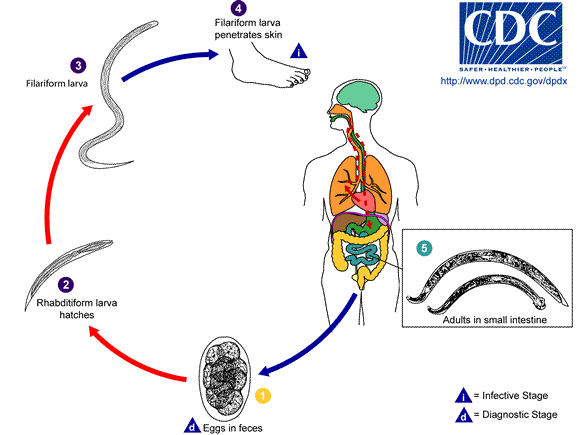Necator Americanus
| Search for Necator Americanus on Wikipedia. |
Necator americanus
[edit | edit source]Necator americanus is a human parasitic worm which belongs to the phylum nematoda. This blood feeding nematode attaches to the small intestine of the host using its teeth, therefore it is commonly known under the name "hookworm". This term is also employed for another human parasite, Ancylostoma duodenalis and other members of the Ancylostomidae family. [1] Hookworm infection is a neglected tropical desease (NTD) widespread through the world, affecting people in areas near the tropics in many countries of Latin America, Africa and Asia. It can cause diarrhea, blood loss, anemia, and as it is usually associated with malnutrition, can affect children’s development and learning skills. Its transmission is related with poor hygiene and economical conditions.[2]
Life cycle
Eggs that are present in feces become larvae within 2 days under favorable conditions of soil humidity and temperature . After a week larvae have molted twice becoming infective larvae L3 which can survive in the soil for a month. In contact with humans, larvae can penetrate the skin of the human host and reach the blood vessels. Then they are carried by the blood stream to the heart and finally the lungs, where larvae penetrate the alveoli, ascend the bronchial tree to the pharynx and are swallowed. Once in the digestive tract, larvae reach the small intestine wall where they attach and mature to become adult worms. Adults can live several years in the intestine lumen where females produce thousands of eggs that are passed in the stool and complete the parasite life cycle. [3]
Current treatment and perspectives
Treatment of hookworm infection consists in oral administration of benzimidazoles as recommended by the World Health Organization. Drugs are very effective for parasite removal [4]. However, since the eggs are present in the environment, reinfection occurs very often and there is the concern of drug resistance development as reported for sheep parasite Haemoncus contortis. [5] Efforts have been made to develop hookworm vaccines in order to avoid constant reinfections.Vaccines containing a mixture of proteins from adult and infective larvae of Necator americanus are currently being tested.[6]
References
- ↑ [1]Loukas A, Constant SL, Bethony JM (2004) Immunobiology of hookworm infection. FEMS IMM and Medical Microbiology. 43: 115-124.
- ↑ [2]Hotez PJ, Brooker S, Bethony JM, Botazzi ME, Loukas A, Xiao S (2004) Hookworm Infection. N Eng J Med. 351:799-806.
- ↑ [3]http://www.dpd.cdc.gov/dpdx/HTML/Hookworm.htm
- ↑ [4]Urbani C, Albonico M (2003) Antihelmintic drug safety and drug administration in the control of soil-transmitted helminthiasis in community campaigns. Acta Tropica 86:215-221.
- ↑ [5]Wolstenholme AJ, Fairweather I, Pitchard R, von Samson-Himmelstjerna G, Sangster NC (2004) Drug resistance in veterinary helminthes. Trends Parasitol 20:469-476.
- ↑ [6]Zhan B, Perally S, Brophy PM, Xue J, Goud G, Liu S, Deumec V, Oliveira LM, Bethony J, Bottazzi ME, Jiang D, Gillespie P, Xiao S, Gupta R, Loukas A, Ranjit N, Lustigman S, Oksov Y, Hotez P (2009) Molecular cloning, Biochemical Characterization, and Partial Protective Immunity of the Heme-Binding Glutatione S-Transferases from Human Hookworm Necator Americanus. Infec and Immunity. 78: 1552-1563.
